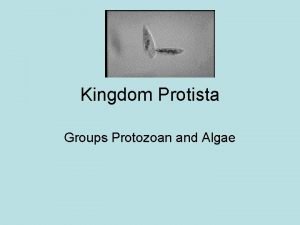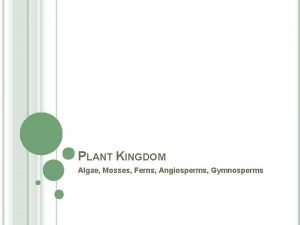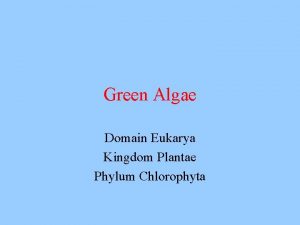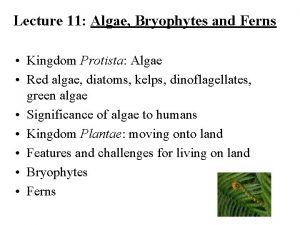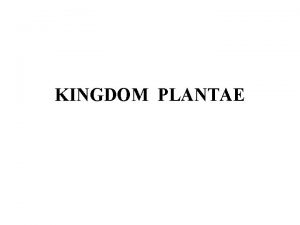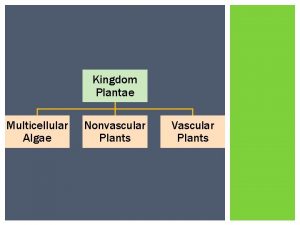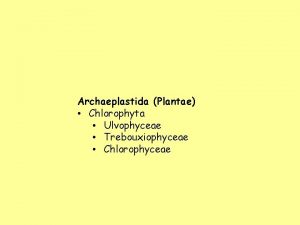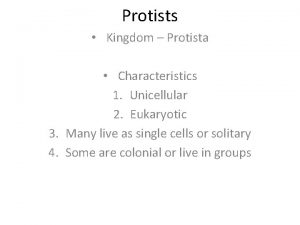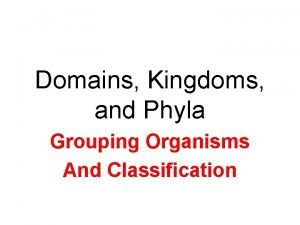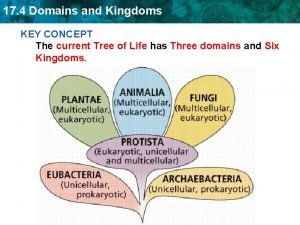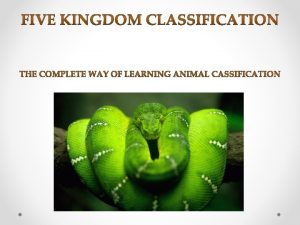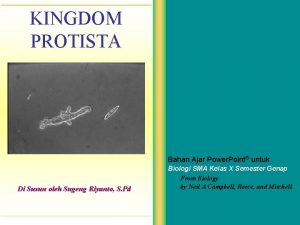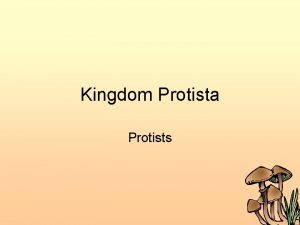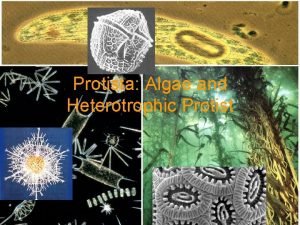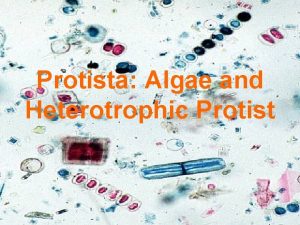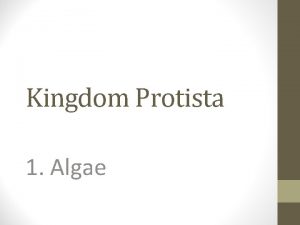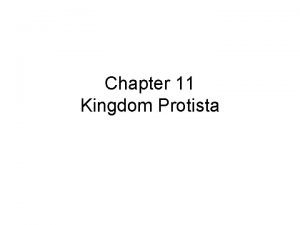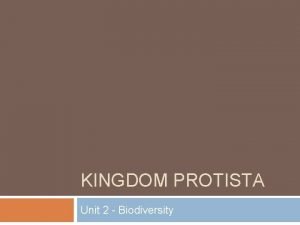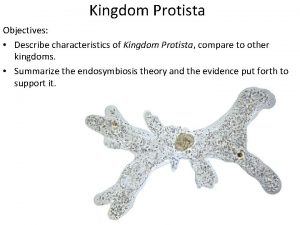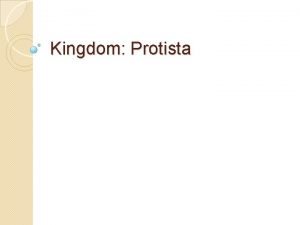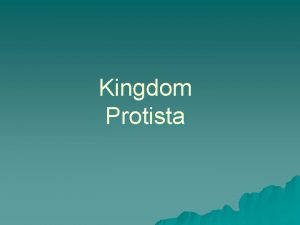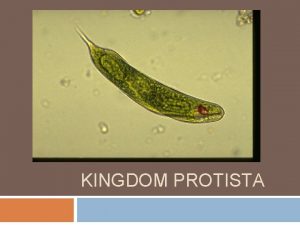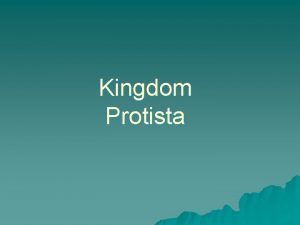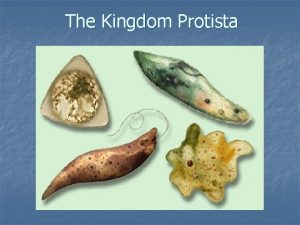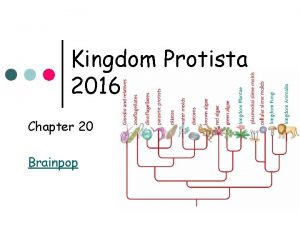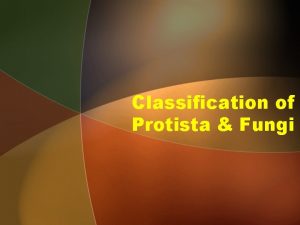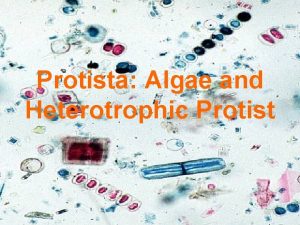Kingdom Protista Groups Protozoan and Algae Systematists have
























- Slides: 24

Kingdom Protista Groups Protozoan and Algae



• Systematists have split protists into many kingdoms • Protists are the most diverse of all eukaryotes – – – Cell structure Nutrition Motility Life cyles Habitats

General characteristics • • Stuck in group First eukaryotic Largest group of 6 kingdoms Multicellular and unicellular Reproduce sex and asexually Divide by mitosis Complex cilia and flagella Autotrophic and heterotrophic

Two Major Groups Protozoans Algae “heterotrophic” “autotrophic”

Importance of studying Protists? • • They are everywhere there is water! Cause diseases Part of food chain Photosynthetic…what is important product? • Recycle nutrients…N, C and P

4 major groups of protozoans 1. 2. 3. 4. Sarcodina Ciliophora Zoomastigina (Mastigophora) Sporozoa

Sacrodina • Amoeba eating a ciliate • Concerns: – Amboeic dysentery: bloody diarrhea, vomiting, extreme stomach cramps, transmitted by contaminated food or water

How do Sacrodina Move? Pseudophodia

Sacrodina Special Characteristics • Asexual or sexual • Contractile vacuole • Eat by Phagocytosis – See animation • Unicellular • Habitat – Ponds – Lakes • Only in Fresh water http: //highered. mcgrawhill. com/sites/9834092339/student_view 0/c hapter 4/animation__cytoplasmic_streaming. html

Ciliophora “The Ciliates” paramecium

How do Ciliophora move? • Cilia

Special Characteristics Ciliophora • • Live in Fresh and salt water environments Respond to chemicals Trichocyst: help capture prey Micronucleus (genetic exchange thru conjugation) • Contractile vacuole – – Store and remove water


Ciliophora Examples – Bursaria – Didinium – Paramecium

Mastigophora • Move by flagella • Habitat: Fresh or salt water • Some are parasitic – Most live on bodies of other organisms

Mastigophora • Volvox • Euglena

Examples of Mastigophora • Trichonympha – Termites: digest cellulose…can we digest it? ? • Giardia – Fever Fatigue, fatal – Transmitted thru water/food from the protist: Giardia lamblia • African sleeping sickness – Fever, lethargy – Bite from a tsetse fly

Sporazoa

Sporazoa • No movement • Produced spores that withstand harsh conditions • Habitat: All parasitic

Examples of Sporazoa • Cryptospordium – Cryptosporidiosis (diarrhea) • Toxoplasmosis – Toxoplasma species • Malaria – destroys RBC – High fever – Delirium – Sweats and chills


• http: //www. brightstorm. com/science/biolog y/classification/protist-kingdom/
 Old kingdom middle kingdom new kingdom
Old kingdom middle kingdom new kingdom Old kingdom middle kingdom new kingdom
Old kingdom middle kingdom new kingdom Old kingdom middle kingdom new kingdom
Old kingdom middle kingdom new kingdom Old kingdom middle kingdom new kingdom
Old kingdom middle kingdom new kingdom Sporazoa
Sporazoa Algae mosses and ferns
Algae mosses and ferns Algae domain
Algae domain Algae kingdom
Algae kingdom Linnaeus
Linnaeus Algae classification
Algae classification Type of algae
Type of algae Kingdom plantae vascular and nonvascular
Kingdom plantae vascular and nonvascular Chromophyta
Chromophyta Blue green algae
Blue green algae Apatococcus
Apatococcus How are ethnic groups and religious groups related
How are ethnic groups and religious groups related Protoctista characteristics
Protoctista characteristics Kingdom protista
Kingdom protista Kingdom protista
Kingdom protista Unicellular fungi examples
Unicellular fungi examples Concept mapping domains and kingdoms
Concept mapping domains and kingdoms Monera classification
Monera classification Monera, protista, fungi, plantae animalia
Monera, protista, fungi, plantae animalia Ppt protista kelas 10
Ppt protista kelas 10 Domain: eukarya kingdom: protista
Domain: eukarya kingdom: protista




